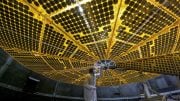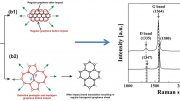
A research team has developed a novel “pulse-shaped” light method to enhance the electrical conductivity of PbS quantum dot solar cells. This new technique, which replaces the lengthy traditional heat treatment process, generates substantial energy at regular intervals, significantly improving efficiency and addressing defects caused by light, heat, and moisture exposure. PbS quantum dots, known for their wide absorption range and low processing costs, are now more viable for commercial use. This advancement is expected to facilitate the broader application of quantum dot technology in optoelectronic devices. Credit: SciTechDaily.com
A new development in solar technology uses pulse-shaped light to enhance the efficiency of PbS quantum dot solar cells, promising easier production and broader application.
A research team headed by Professor Jongmin Choi from the Department of Energy Science and Engineering at Daegu Gyeongbuk Institute of Science and Technology has successfully developed a “PbS quantum dot” capable of quickly improving the electrical conductivity of solar cells. This collaborative effort involved Professor Changyong Lim of the Department of Energy Chemical Engineering at Kyungpook National University, led by President Wonhwa Hong, and Professor Jongchul Lim from the Department of Energy Engineering at Chungnam National University, under the leadership of President Jeongkyoum Kim.
The team identified a method to enhance electrical conductivity through the use of “pulse-shaped” light, which generates substantial energy in a concentrated manner at regular intervals. This method could replace the heat treatment process, which requires a significant amount of time to achieve the same result. This approach is expected to facilitate the production and commercialization of PbS quantum dot solar cells in the future.
Benefits of PbS Quantum Dots
PbS quantum dots are nanoscale semiconductor materials that are being actively researched for the development of next-generation solar cells. They can absorb a wide range of wavelengths of sunlight, including ultraviolet, visible light, near-infrared, and shortwave infrared, and have low processing costs because of solution processing and excellent photoelectric properties.
The fabrication of PbS quantum dot solar cells involves several process steps. Until recently, the heat treatment process was considered an essential step as it effectively coats a layer of quantum dots onto a substrate and heat-treats the material to further increase its electrical conductivity. However, when PbS quantum dots are exposed to light, heat, and moisture, the formation regarding defects on their surface can be accelerated, leading to charge recombination and deterioration of device performance. This phenomenon makes it challenging to commercialize these materials.
Innovative Heat Treatment Technique
To suppress the formation of defects on the surface of PbS quantum dots, a team led by Professor Jongmin Choi proposed a heat treatment involving the exposure of the dots to light for a brief period of a few milliseconds. Conventional techniques for heat-treating PbS quantum dot layers involve heating them for tens of minutes at high temperatures using hot plates, ovens, etc.
The research team’s proposed “pulse-type heat treatment technique” overcomes the shortcomings of the existing method by using strong light to complete the heat treatment process in a few milliseconds. This results in the suppression of surface defects and the extension of the traveling life of charges (electrons, holes) that generate electric current. Furthermore, it achieves high efficiency.
“Through this research, we were able to improve the efficiency of solar cells by developing a new heat treatment process that can overcome the limitations of the existing quantum dot heat treatment process,” said Professor Jongmin Choi of the Department of Energy Science and Engineering at DGIST. ”Furthermore, the development of a quantum dot process with excellent ripple effect is expected to facilitate the widespread application of this technology to a range of optoelectronic devices in the future,” he added.
Reference: “Suppression of Thermally Induced Surface Traps in Colloidal Quantum Dot Solids via Ultrafast Pulsed Light” by Eon Ji Lee, Wonjong Lee, Tae Ho Yun, Hyung Ryul You, Hae Jeong Kim, Han Na Yu, Soo-Kwan Kim, Younghoon Kim, Hyungju Ahn, Jongchul Lim, Changyong Yim and Jongmin Choi, 2 April 2024, Small.
DOI: 10.1002/smll.202400380
This research was supported by the Creative Allied Project of The National Research Council of Science and Technology of Korea, the Basic Research Lab Project of The National Research Foundation of Korea, and the Regional Innovation Leading Research Center for Carbon-Neutral Intelligent Energy System of Kyungpook National University. The results were published online in the international journal, “Small” (co-first author: Eonji Lee, PhD student, Department of Energy Science and Engineering, DGIST, and Wonjong Lee, MSc integrated student, Department of Energy Engineering, Chungnam National University).









Ihave building a project superconducting quantum computer project in thé World technology